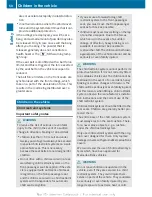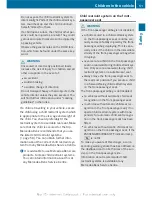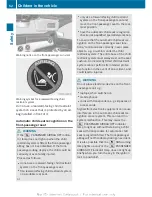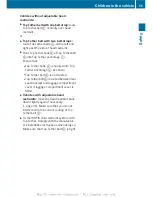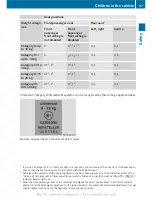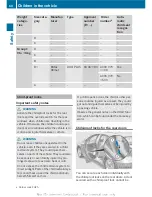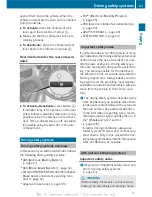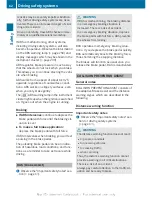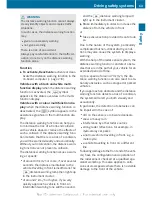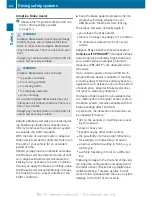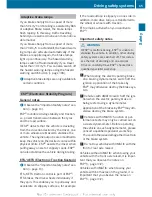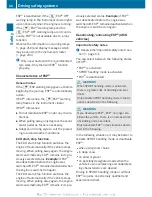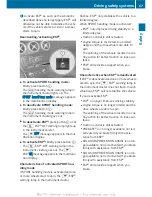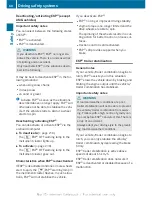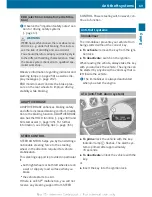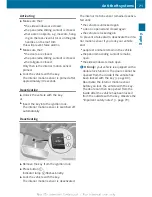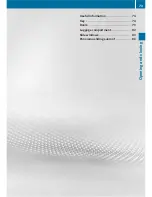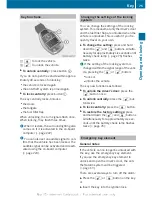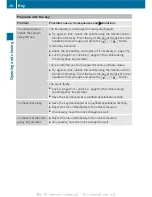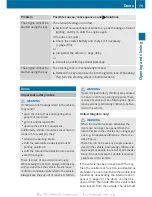
Adaptive Brake Assist
i
Observe the "Important safety notes" sec-
tion for driving safety systems
(
Y
page 61).
G
WARNING
Adaptive Brake Assist cannot always clearly
identify objects and complex traffic situa-
tions. In these cases, Adaptive Brake Assist
may not intervene. There is a risk of an acci-
dent.
Always pay careful attention to the traffic sit-
uation and be ready to brake.
G
WARNING
Adaptive Brake Assist does not react:
R
to people or animals
R
to oncoming vehicles
R
to crossing traffic
R
to stationary obstacles
R
when cornering
As a result, Adaptive Brake Assist may not
intervene in all critical conditions. There is a
risk of an accident.
Always pay careful attention to the traffic sit-
uation and be ready to brake.
Adaptive Brake Assist aids you in braking dur-
ing hazardous situations at speeds above
30 km/h and uses the radar sensor system
to evaluate the traffic situation.
With the help of a sensor system, adaptive
Brake Assist can detect obstacles that are in
the path of your vehicle for an extended
period of time.
Should you approach an obstacle and adap-
tive Brake Assist has detected a risk of colli-
sion, adaptive Brake Assist calculates the
braking force necessary to avoid a collision.
Should you apply the brakes forcefully, adap-
tive Brake Assist will automatically increase
the braking force to a level suitable for the
traffic conditions.
X
Keep the brake pedal depressed until the
emergency braking situation is over.
ABS prevents the wheels from locking.
The brakes will work normally again if:
R
you release the brake pedal
R
there is no longer any danger of a collision
R
no obstacle is detected in front of your
vehicle
Adaptive Brake Assist is then deactivated.
Vehicles with PRE-SAFE
®
: if adaptive Brake
Assist requires particularly high brake pres-
sure, preventative passenger protection
measures (PRE-SAFE
®
) are deployed simul-
taneously.
Up to vehicle speeds of around 250 km/h,
adaptive Brake Assist is capable of reacting
to moving objects that have already been rec-
ognised as such at least once over the period
of observation. Adaptive Brake Assist does
not react to stationary obstacles.
If adaptive Brake Assist is not available due
to a malfunction in the radar sensor system,
the brake system remains available with full
brake boosting effect and BAS.
In particular, the detection of obstacles can
be impaired if there is:
R
dirt on the sensors or anything else cover-
ing the sensors
R
snow or heavy rain
R
interference by other radar sources
R
the possibility of strong radar reflections,
for example, in multi-storey car parks
R
a narrow vehicle travelling in front, e.g. a
motorcycle
R
a vehicle travelling in front on a different
line
Following damage to the front end of the vehi-
cle, have the configuration and operation of
the radar sensor checked at a qualified spe-
cialist workshop. This also applies to colli-
sions at slow speeds where there is no visible
damage to the front of the vehicle.
64
Driving safety systems
Safety
Summary of Contents for 2012 A-Class
Page 1: ...A Class Owner s Manual Nur für internen Gebrauch For internal use only ...
Page 4: ......
Page 28: ...26 ...
Page 40: ...38 ...
Page 74: ...72 ...
Page 92: ...90 ...
Page 284: ...282 ...
Page 285: ...Useful information 284 Engine compartment 284 Service 289 Care 290 283 Maintenance and care ...
Page 336: ...334 ...
Page 353: ...351 ...
Page 354: ...352 ...

